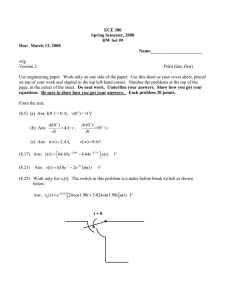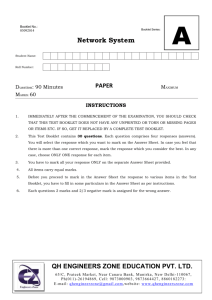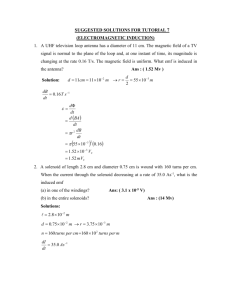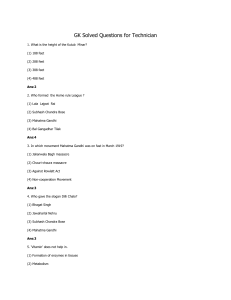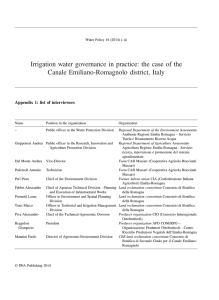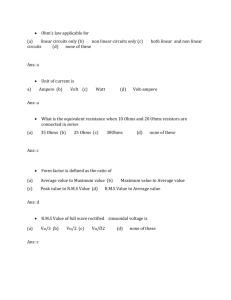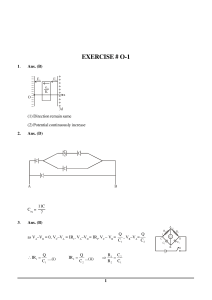Hydrology & Irrigation Engg. (Civil Engineering)
advertisement
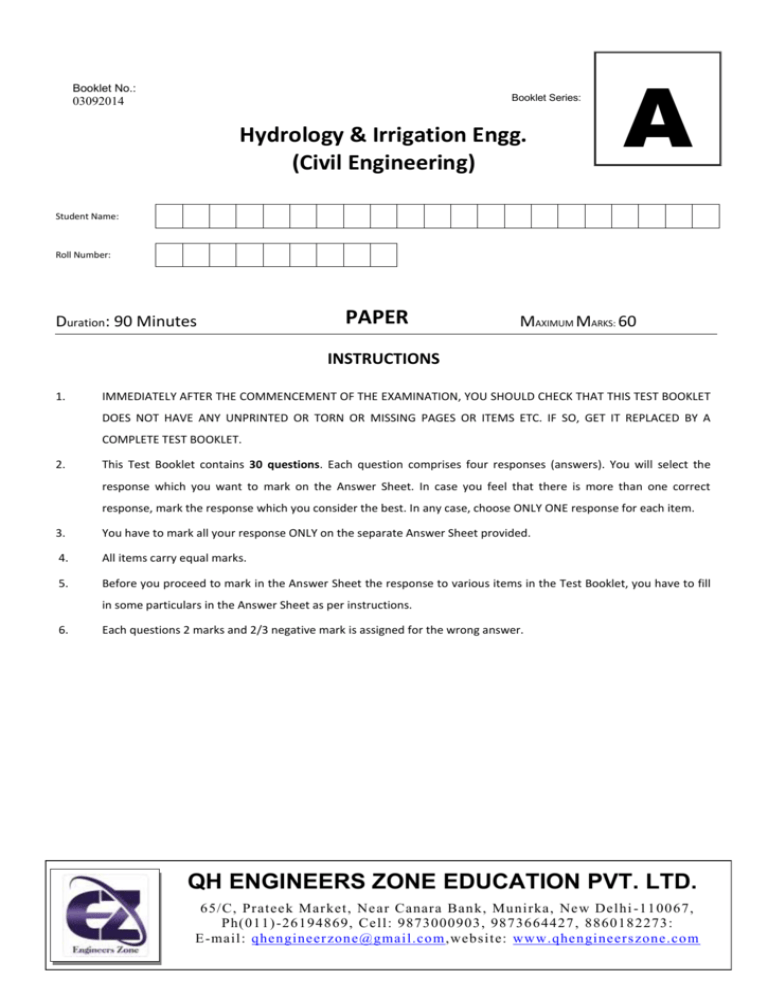
CWT–04 Booklet No.: Booklet Series: 03092014 Hydrology & Irrigation Engg. (Civil Engineering) A Student Name: Roll Number: Duration: 90 Minutes PAPER MAXIMUM MARKS: 60 INSTRUCTIONS 1. IMMEDIATELY AFTER THE COMMENCEMENT OF THE EXAMINATION, YOU SHOULD CHECK THAT THIS TEST BOOKLET DOES NOT HAVE ANY UNPRINTED OR TORN OR MISSING PAGES OR ITEMS ETC. IF SO, GET IT REPLACED BY A COMPLETE TEST BOOKLET. 2. This Test Booklet contains 30 questions. Each question comprises four responses (answers). You will select the response which you want to mark on the Answer Sheet. In case you feel that there is more than one correct response, mark the response which you consider the best. In any case, choose ONLY ONE response for each item. 3. You have to mark all your response ONLY on the separate Answer Sheet provided. 4. All items carry equal marks. 5. Before you proceed to mark in the Answer Sheet the response to various items in the Test Booklet, you have to fill in some particulars in the Answer Sheet as per instructions. 6. Each questions 2 marks and 2/3 negative mark is assigned for the wrong answer. QH ENGINEERS ZONE EDUCATION PVT. LTD. 65/C, Prateek Mar ket, Ne ar Canara Bank, Munirka, New Delhi -110067, Ph(011) -26194869, Cell: 9873000903, 9873664427 , 8860182273: E-mail: qhengineer zone@gmail.com ,website: www.qhengineerszone.com 1 QH Engineers Zone, 65/C, Near Prateek Market, Canara Bank, Munirka, New Delhi-110067, P h ( 0 1 1 ) - 2 6 1 9 4 8 6 9 , C e l l : 9 8 7 3 0 0 0 9 0 3 , 9 8 7 3 6 6 4 4 2 7 : E - ma i l : q h e n g i n e e r z o n e @ g ma i l . c o m Hydrology & Irrigation Engg. Hydrology Engineering (1.) Rainfall of intensity of 15 mm/h occurred over a area of 100 ha for 5 hours. Measured direct runoff volume was found to be 15000 m3. The precipitation not available for runoff in this case is: (a.) 6 cm (b.) 8 cm (c.) 27.5 cm (d.) 50 cm Ans: a Exp: Total volume of rainfall 15 103 5 100 10000 m3 75000 m3 pp n not available for runoff is 75000 15000 60000 m3 60000 0.06 m 10000 100 (2.) 6 cm The double mass curve technique is adopted to: (a.) Check the consistency of rain gauge records (b.) To find the average rainfall over a number of years (c.) To find the number of rain gauges required (d.) To estimate the missing rainfall data Ans: a (3.) The coefficient of variation of the rainfall for six rain gauge stations in catchments was found to be 29.54%. The optimum number of stations in the catchments for an admissible 10% error in the estimation of the mean rainfall will be: (a.) 3 (b.) 6 (c.) 9 (d.) 12 Ans: c Exp: No. of optimum station 2 EN G IN EER S ZO N E, 6 5 / C , P r at ee k Ma r k et , Ne ar C an a ra B an k, Mu n i r ka, N ew Del h i -1 1 0 0 6 7 , P h (0 1 1 ) -2 6 1 9 4 8 6 9 , C e l l: 9 8 7 3 0 0 0 9 0 3 , 9 8 7 3 6 6 4 4 2 7: E - ma i l : q h en gi n e er zo n e @ g m ai l . co m Hydrology & Irrigation Engg. CV N E 2 4 29.54 8.726 10 (4.) 9 stations The shape of the recession limb of a hydrograph depends on: (a.) Basin as well as storm characteristics (b.) Storm characteristics only (c.) Basin characteristics only (d.) Base flow only Ans: c (5.) Evaporation aspiration is confined (a.) To day light hours (b.) To night time only (c.) Land surfaces only (d.) None of these Ans: d (6.) The rainfall on five successive days on a catchment was 2, 8, 9, 2 and 3 cm. If -index for the storm can be assumed to be 1.5 cm/day, the total direct runoff from the catchment is (a.) 26 cm (b.) 12 cm (c.) 13 cm (d.) 14 cm Ans: d Exp: Direct runoff = (0.8 – 1.5) + (9 – 1.5) = 14 cm (7.) Interception losses includes: (a.) Only evaporation loss (b.) Evaporation, through flow & stem flow (c.) Evaporation & transpiration (d.) Only steam flow Ans: c (8.) If the wind velocity at a height of 3 m above ground is 6 kmph, its value at a height of 10 m above ground is: 3 EN G IN EER S ZO N E, 6 5 / C , P r at ee k Ma r k et , Ne ar C an a ra B an k, Mu n i r ka, N ew Del h i -1 1 0 0 6 7 , P h (0 1 1 ) -2 6 1 9 4 8 6 9 , C e l l: 9 8 7 3 0 0 0 9 0 3 , 9 8 7 3 6 6 4 4 2 7: E - ma i l : q h en gi n e er zo n e @ g m ai l . co m Hydrology & Irrigation Engg. (a.) 8.5 Km/hr (b.) 9.5 Km/hr (c.) 7.1 Km/hr (d.) 12 Km/hr Ans: c Exp: un Ch 1/7 (9.) 6 C 3 C 5.129 u10 5.129 10 1/7 1/7 7.127 km/h A colvert is designed for a flood magnitude of return period 120 years & has expected life of 25 years. The risk in this hydrologic design is (a.) 1 0.0125 (b.) 0.1 0.9925 (c.) 1 0.09120 (d.) 1 0.1025 Ans: b Exp: We know that risk n 1 R 1 1 T 1 1 1 120 25 1 0.9925 (10.) The DRH due to isolated storm is as shown in the figure, if the catchment area is 1500 km2, the effective rainfall of the storm is (a.) 2.5 104 cm 4 EN G IN EER S ZO N E, 6 5 / C , P r at ee k Ma r k et , Ne ar C an a ra B an k, Mu n i r ka, N ew Del h i -1 1 0 0 6 7 , P h (0 1 1 ) -2 6 1 9 4 8 6 9 , C e l l: 9 8 7 3 0 0 0 9 0 3 , 9 8 7 3 6 6 4 4 2 7: E - ma i l : q h en gi n e er zo n e @ g m ai l . co m Hydrology & Irrigation Engg. (b.) 1.6 104 cm (c.) 2.6 104 cm (d.) 1.5 104 cm Ans: d Exp: Total runoff = Area of figure 20 20 1 1 80 50 10 20 2 2 2300 m3 R Area of catchment A 1500 km2 Eff. Rainfall R A 2300 1500 106 1.533 104 cm (11.) In a linear reservoir, the (a.) Volume varies linearly with elevation (b.) Outflow rate varies linearly with storage (c.) Storage varies linearly with time (d.) Storage varies linearly with inflow rate Ans: b Exp: For linear reservoir the equation is S = KQ. Where S = Storage, Q = out flow rate. (12.) If the base period of a 6 hour hydrograph of a basin is 84 hours, then a 12 hours unit hydrograph derived from this 6 hour with hydrograph will have a base period of (a.) 75 hours (b.) 78 hours (c.) 84 hours (d.) 90 hours Ans: d Exp: 84 + 6 = 90 hours. 5 EN G IN EER S ZO N E, 6 5 / C , P r at ee k Ma r k et , Ne ar C an a ra B an k, Mu n i r ka, N ew Del h i -1 1 0 0 6 7 , P h (0 1 1 ) -2 6 1 9 4 8 6 9 , C e l l: 9 8 7 3 0 0 0 9 0 3 , 9 8 7 3 6 6 4 4 2 7: E - ma i l : q h en gi n e er zo n e @ g m ai l . co m Hydrology & Irrigation Engg. (13.) A DRH due to a storm over a basin has a time base of 80 hours with straight line portions of the hydrograph with flow rates of 0, 20, 70, 90, 40 & 0 m3/s at elapsed durations of 0, 10, 30, 40, 50 & 80 hours as indicated on the diagram given below, respectively. The catchment area is 250 km2. What is the rainfall excess in this storm? (a.) 2.91 cm (b.) 3.91 cm (c.) 3.51 cm (d.) 3.67 cm Ans: (d) Exp: Area under DRH 1 20 70 70 90 10 20 20 2 2 2 1 90 40 10 10 30 40 2 2 2550 m3 hr 9.18 106 m3 s Rainfall excess 9.18 106 m3 250 106 = 0.037m = 3.672 cm. (14.) An instantaneous unit hydrograph is a hydrograph of(a.) Unit duration & infinitely small rainfall excess (b.) Infinitely small duration & of unit rainfall excess (c.) Infinitely small duration & of unit rainfall excess of an infinitely small area (d.) Unit rainfall excess on infinitely small area Ans: b (15.) The Muskingum channel routing equation is written for the outflow from the reach Q in terms of the inflow I & coefficients C0, C1 & C2 as: (a.) Q2 C0 I 0 C1Q1 C2 I 2 (b.) Q2 C0 I 2 C1I1 C2Q2 6 EN G IN EER S ZO N E, 6 5 / C , P r at ee k Ma r k et , Ne ar C an a ra B an k, Mu n i r ka, N ew Del h i -1 1 0 0 6 7 , P h (0 1 1 ) -2 6 1 9 4 8 6 9 , C e l l: 9 8 7 3 0 0 0 9 0 3 , 9 8 7 3 6 6 4 4 2 7: E - ma i l : q h en gi n e er zo n e @ g m ai l . co m Hydrology & Irrigation Engg. (c.) Q2 C0 I 0 C1I1 C2 I 2 (d.) Q2 C0Q0 C1Q1 C2 I 2 Ans: b Irrigation Engineering (16.) Given that the base period is 100 days & the duty of canal is 1000 hectares per cumecs, the depth of water will be (a.) 0.864 cm (b.) 8.64 cm (c.) 86.4 cm (d.) 864 cm Ans: c Exp: D 864 B D 100 ha/cumec B 100 days (17.) 864 100 86.4 cm 1000 For a culturable command area of 1000 hectare with intensity if irrigation of 50%, the duty on field for a certain crop is 2000 hectare/cumec. What is the discharge required at head of water course with 25% losses of water? (a.) 3/16 cumec (b.) 1/4 cumec (c.) 1/3 cumec (d.) 1/2 cumec Ans: c Exp: The proposed area to be irrigated = CCA × Intensity of irrigation = 1000 × 0.5 = 500 hectare The discharge needed 500 = 0.25 cumec 2000 If 25% water is lost the discharge required 7 0.25 100 75 EN G IN EER S ZO N E, 6 5 / C , P r at ee k Ma r k et , Ne ar C an a ra B an k, Mu n i r ka, N ew Del h i -1 1 0 0 6 7 , P h (0 1 1 ) -2 6 1 9 4 8 6 9 , C e l l: 9 8 7 3 0 0 0 9 0 3 , 9 8 7 3 6 6 4 4 2 7: E - ma i l : q h en gi n e er zo n e @ g m ai l . co m Hydrology & Irrigation Engg. (18.) 1 cumec 3 Assertion (A): In the boarder strip method of irrigation, the size of the strip depends on soil characteristics, slope of the land & discharge. Reason (R): Border strip method is a controlled type of subsurface irrigation method. (a.) Both A and R are true & R is the correct explanation of A (b.) Both A and R are true & R is not correct explanation of A (c.) A is true but R is false (d.) A is false but R is true Ans: c (19.) What is the SAR value for irrigation water with following characteristics: NA – 22 meq/e, Ca – 3 meq/e, Mg – 1.5 meg/l (a.) 14.67 (b.) 19.67 (c.) 20.67 (d.) 18.67 Ans: a (20.) The delta for a crop when its duty is 864 hectares/cumec. On the field, the base period of this crop is 100 days is: (a.) 120 cm (b.) 102 cm (c.) 100 cm (d.) 104.8 cm Ans: c Exp: 864 (21.) B 864 100 100 cm D 864 Duty: (a.) Increases as one moves downstream from the head of the main canal towards the head of the water courses (b.) Decreases as one moves downstream from the head of the main canal towards the head of the water courses (c.) Remains constant as one moves downstream from the head of the main canal towards the head of the water courses 8 EN G IN EER S ZO N E, 6 5 / C , P r at ee k Ma r k et , Ne ar C an a ra B an k, Mu n i r ka, N ew Del h i -1 1 0 0 6 7 , P h (0 1 1 ) -2 6 1 9 4 8 6 9 , C e l l: 9 8 7 3 0 0 0 9 0 3 , 9 8 7 3 6 6 4 4 2 7: E - ma i l : q h en gi n e er zo n e @ g m ai l . co m Hydrology & Irrigation Engg. (d.) Will be zero at downstream at the head of water courses Ans: d (22.) Assertion (A): Lining a canal is always beneficial & economical. Reason (R): The seepage losses are greatly reduced & extra water is available for irrigation. (a.) Both A and R are true & R is the correct explanation of A (b.) Both A and R are true & R is not correct explanation of A (c.) A is true but R is false (d.) A is false but R is true Ans: d (23.) The permanent wilting point is the water content at which (a.) The growth of plant is optimum (b.) The plant dies (c.) The plants growth is maximum (d.) The plants growth is minimum Ans: b (24.) The cost of construction of cross drainage works decreases if: (a.) Canal is aligned along the slope (b.) Canal is aligned along the watershed or ridge line (c.) Canal is aligned along the contours (d.) None of the above Ans: b (25.) Statement-1: Kennedy stated all the channels to be in state of regime provided they did not silt or scour. Statement-2: Lacey differentiated between two regime conditions i.e. initial regime & final regime. Of the two statements above: (a.) Both (1) and (2) are correct (b.) Both (1) and (2) are wrong (c.) (1) is wrong and (2) is correct (d.) (2) is wrong and (1) is correct Ans: a (26.) 9 Leaching requirement is given as: EN G IN EER S ZO N E, 6 5 / C , P r at ee k Ma r k et , Ne ar C an a ra B an k, Mu n i r ka, N ew Del h i -1 1 0 0 6 7 , P h (0 1 1 ) -2 6 1 9 4 8 6 9 , C e l l: 9 8 7 3 0 0 0 9 0 3 , 9 8 7 3 6 6 4 4 2 7: E - ma i l : q h en gi n e er zo n e @ g m ai l . co m Hydrology & Irrigation Engg. (Where Dd = Depth of water drained out per unit area and Di = Depth of irrigation water applied per unit of area). (a.) Dd Di (b.) Di Dd (c.) Dd Di (d.) Dd Di Ans: a (27.) For canal head regular following statements are made: 1. It regulates the supply of water entering the canal 2. It controls the entry of silt in the canal 3. It prevents the river floods from entering the canal Which of the above statements are correct: (a.) 1, 2 and 3 (b.) Only 1 (c.) Only 1 and 2 (d.) Only 2 and 3 Ans: a (28.) Canal Fall is a: (a.) Diversion structure (b.) Cross-drainage structure (c.) Regulating structure (d.) River training structure Ans: c (29.) The uplift pressure acting on the base of the dam; (Where H’ = Hydrostatic pressure at toe, H = Hydrostatic pressure at heel) (a.) Is constant (b.) Is equal to hydrostatic pressure at heel & toe & joined by a straight line in between (c.) Varies linearly with maximum at heel & zero at toe 1 (d.) Is given by the equation w H w H w H 3 10 EN G IN EER S ZO N E, 6 5 / C , P r at ee k Ma r k et , Ne ar C an a ra B an k, Mu n i r ka, N ew Del h i -1 1 0 0 6 7 , P h (0 1 1 ) -2 6 1 9 4 8 6 9 , C e l l: 9 8 7 3 0 0 0 9 0 3 , 9 8 7 3 6 6 4 4 2 7: E - ma i l : q h en gi n e er zo n e @ g m ai l . co m Hydrology & Irrigation Engg. Ans: b (30.) In a concrete gravity dam, with a sloping upstream face, the resisting force is provided by the: (a.) Weight of the dam (b.) Weight of the water supported on the upstream slope (c.) Both (a) and (b) (d.) None of these Ans: c (31.) (a.) (b.) (c.) (d.) Ans: 11 EN G IN EER S ZO N E, 6 5 / C , P r at ee k Ma r k et , Ne ar C an a ra B an k, Mu n i r ka, N ew Del h i -1 1 0 0 6 7 , P h (0 1 1 ) -2 6 1 9 4 8 6 9 , C e l l: 9 8 7 3 0 0 0 9 0 3 , 9 8 7 3 6 6 4 4 2 7: E - ma i l : q h en gi n e er zo n e @ g m ai l . co m
